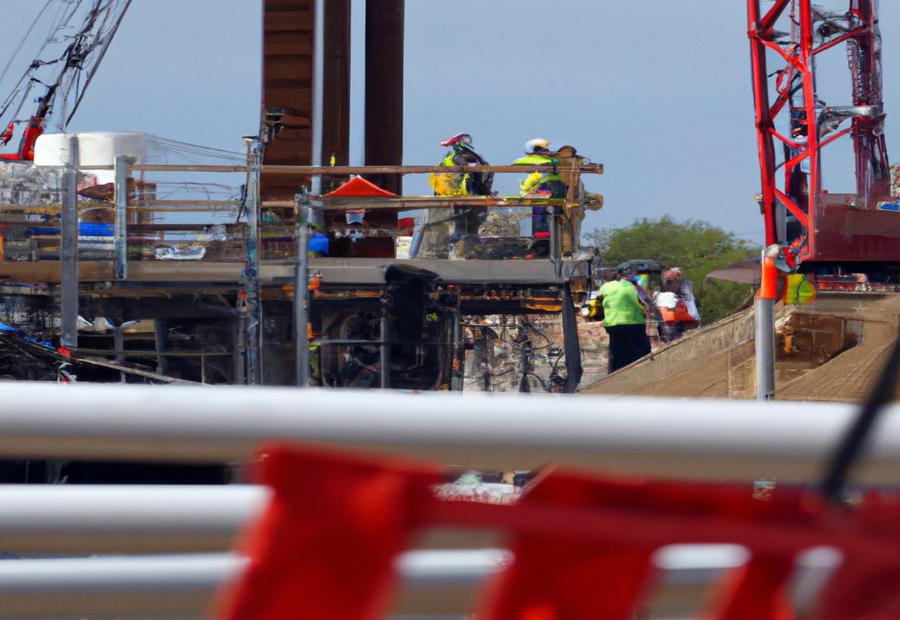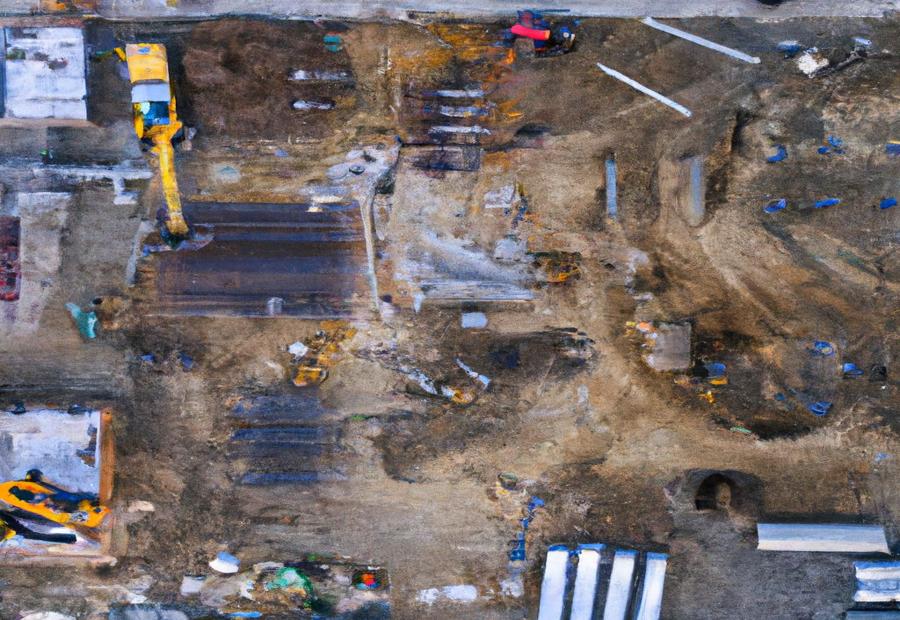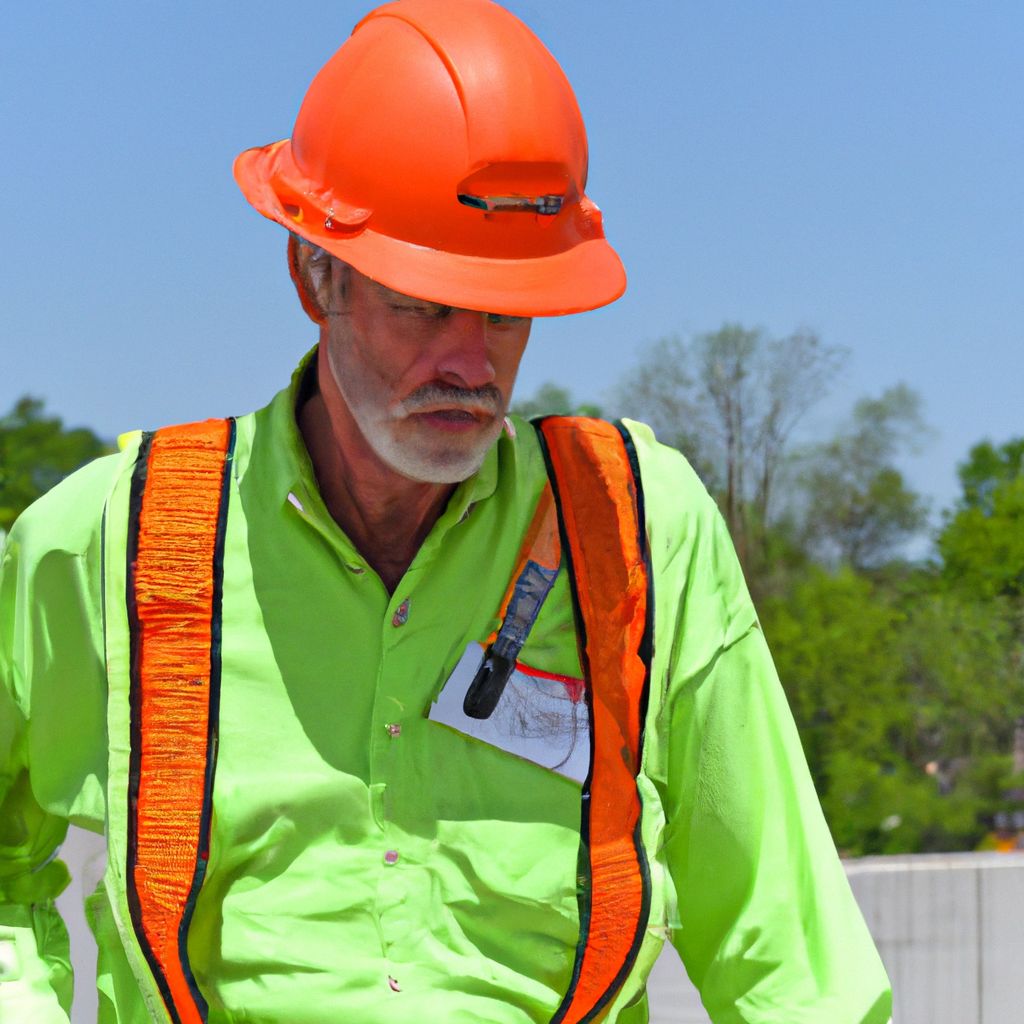Key Takeaways:
- Importance of Safety Training and Induction: Providing proper safety training and induction for all employees is crucial to ensure their understanding of safety protocols and procedures on the construction site.
- Use of Personal Protective Equipment: Encouraging and enforcing the use of personal protective equipment, such as hard hats, safety glasses, and reflective vests, can significantly reduce the risk of injuries on the construction site.
- Promoting a Strong Safety Culture: Fostering a culture of safety among all workers and emphasizing the importance of everyone’s responsibility in prioritizing safety can create a safer working environment on the construction site.
Key Takeaways:
1. Importance of Safety Training and Induction: Providing proper safety training and induction for all employees is crucial to ensure their understanding of safety protocols and procedures on the construction site.
2. Use of Personal Protective Equipment: Encouraging and enforcing the use of personal protective equipment, such as hard hats, safety glasses, and reflective vests, can significantly reduce the risk of injuries on the construction site.
3. Promoting a Strong Safety Culture: Fostering a culture of safety among all workers and emphasizing the importance of everyone’s responsibility in prioritizing safety can create a safer working environment on the construction site.



Photo Credits: Build-Wire.Com by Bobby Martinez
Unsafe construction sites can lead to devastating accidents and even loss of life. In this article, we will explore the essential tips and strategies to ensure safety on your construction site. We will discuss the importance of prioritizing safety and the commitment of executive officers to creating a secure working environment. By understanding these key factors, you can not only protect the well-being of your workers but also increase productivity and avoid costly legal and financial consequences.
Importance of Safety on Construction Sites
Safety on construction sites is of the utmost importance. Risks and hazards are common in these environments, so executive officers must prioritize safety and make sure precautionary steps are taken.
To ensure safety, comprehensive safety training and induction programs must be provided to workers. They need to know potential risks and have the skills to work safely. Personal Protective Equipment (PPE) should be worn at all times – this includes hard hats, gloves, goggles, and high-visibility clothing.
Site security is important, too. Access control must be implemented, surveillance systems installed, and valuable assets secured to deter criminals.
Injuries and fatalities must be prevented. Inspections of equipment/tools, identifying hazards, and implementing safety protocols (fall protection systems, scaffolding regulations, electrical safety guidelines) should be done regularly.
Tools and equipment must also be tracked, storage areas secured, and inventories checked.
Additionally, a strong safety culture needs to be promoted. Everyone should feel comfortable reporting hazards or unsafe practices, and safety policies and expectations should be communicated regularly.
Emergency preparedness is a must. Emergency response plans should include evacuation procedures, first aid training, and necessary emergency equipment.
Executive Officers’ Commitment to Safety
Executive officers understand the importance of safety and prioritize it. They lead by example, creating a culture where safety protocols and measures are valued. Safety training and induction programs equip workers with the knowledge and skills to perform their tasks safely. Executives also ensure sufficient PPE is provided and enforced.
Maintaining site security is another priority – access control systems, secure equipment storage areas, and regular inspections identify and mitigate potential threats. Plus, risk assessment and hazard identification processes are implemented to prevent injuries and fatalities.
Executive officers’ commitment to safety is further evident in their efforts to foster a strong safety culture. Open communication channels allow employees to report concerns or near misses without fear of reprisal. This empowers everyone to take ownership of their own safety and that of their colleagues.
Essential Tips for Ensuring Safety on Your Construction Site



Photo Credits: Build-Wire.Com by Dylan White
Construction site safety is paramount for the well-being of workers and the success of any project. In this section, we will explore essential tips that can help ensure safety on your construction site. From the importance of safety training and induction to promoting a strong safety culture, we will discuss key strategies to prevent injuries, theft, and loss of valuable assets. Additionally, we will examine the significance of personal protective equipment and emergency preparedness in maintaining a secure and efficient construction site.
Importance of Safety Training and Induction
Safety training and induction are vital to the safety of construction sites. By teaching workers the necessary skills and knowledge, these programs help avoid accidents, injuries, and fatalities.
Workers are taught the potential risks they might face onsite. They learn how to use tools, handle materials, and work in certain areas safely. This helps them take the right precautions and reduce the chances of accidents.
Moreover, safety training and induction create a culture of safety. By stressing the importance of following safety protocols, everyone is reminded that their safety is essential. This encourages workers to be accountable and look out for each other.
In addition to preventing accidents, safety training and induction also guarantee site security. Workers are taught to recognize unauthorized people or activities that could compromise the security. They know how to report suspicious behavior promptly and stop theft or loss of assets.
By focusing on safety training and induction, employers show that they are devoted to keeping their employees safe. This safeguards workers from harm and boosts productivity by avoiding lost workdays due to injuries.
Use of Personal Protective Equipment
The use of Personal Protective Equipment (PPE) is essential for safety on construction sites. It’s an essential line of defence against potential risks, helping to protect against injuries & fatalities.
- PPE includes things like hard hats, safety glasses, earplugs/earmuffs, gloves & hi-vis clothing.
- Wearing the right PPE can reduce the risk of head injuries from falling objects, eye damage from debris/chemicals, hearing damage from loud noises, hand injuries from sharp tools/materials & visibility-related accidents.
- It’s important to inspect & maintain PPE regularly, to ensure it’s effective in protecting workers.
- Workers should be given proper training & education on the correct use & care of PPE.
Using PPE properly not only safeguards individuals, but also helps create a strong safety culture on construction sites. By ensuring that all workers have access to & use appropriate PPE, the risk of accidents & injuries can be greatly reduced.
It’s key to not only provide employees with PPE, but to educate them on its correct use & maintenance. This includes inspecting for wear & tear/damage, replacing when necessary & training sessions to reinforce safe practices. By emphasizing the use of PPE in all aspects of construction site operations, companies can make a safer work environment for their employees. Building walls is important, but protecting your construction site is essential – keep out intruders & bad jokes!
Ensuring Site Security
Securing a construction site is mandatory for maintaining a safe environment! Set up perimeter fencing to deter unauthorized entry & keep out theft & vandalism. Use access control systems like ID cards & biometric scanners to allow only qualified personnel into restricted areas. Surveillance cameras provide real-time video footage for review in case of incidents.
Security personnel at entrances & exits help to control access & patrol the site. Lockable containers, secured storage areas & marked inventory lists secure equipment & materials. Lastly, collaborate with local law enforcement for quick response in emergencies.
Safety on a construction site is imperative! Implementing these strategies ensures a secure environment where work can progress smoothly – without losing lives or money!
Preventing Injuries and Fatalities
Promoting a strong safety culture is a must. This means creating an environment where safety comes first. Open communication between workers and management regarding safety is a must, as well as rewarding positive safety behavior.
Emergency preparedness is crucial too. Defined emergency plans, drills and first aid facilities can help reduce injury in case of an accident.
Theft prevention is key to minimizing financial losses and potential risks. Securing equipment with locks and surveillance systems, implementing inventory control measures and conducting regular audits can help.
Preventing Theft and Loss of Valuable Assets
Preventing theft and loss of valuable assets is crucial for safety on construction sites. Proactive measures should be taken to protect such assets, as these incidents can lead to financial losses and delays. Here’s a 5-step guide to effectively prevent theft and loss:
- Implement strict access control: Limit site access to authorized personnel only. Use access control systems such as ID badges, biometric scanners, or security guards.
- Use secure storage containers: Lockable and break-in-proof containers should be used to store tools, equipment, and materials. Place them in well-lit areas and monitor with cameras.
- Conduct regular inventory checks: Maintain an accurate inventory of all valuable assets. Regularly compare the actual inventory to the recorded data, and investigate any discrepancies.
- Install surveillance cameras: Place surveillance cameras at strategic locations to deter thieves and provide visual evidence in case of theft.
- Foster a culture of vigilance: Encourage employees to be vigilant and report any suspicious activities or individuals. Hold regular safety meetings and emphasize the importance of reporting any security breaches promptly.
Other measures include collaborating with local authorities, establishing reporting protocols, and providing training about site security protocols. Pro Tip: Ensure asset labeling with unique identifiers to aid in tracking and recovering stolen assets.
Promoting a Strong Safety Culture
Promoting a strong safety culture on construction sites takes more than just following regulations. Regular discussions about site-specific risks, inspections and addressing any issues quickly are ways to show safety is important. Providing safety training ensures workers know how to identify hazards, use equipment safely and follow work practices.
Good communication between management, supervisors and workers helps report potential hazards or unsafe conditions. Encouraging workers to voice their concerns and ideas creates a sense of collaboration and ownership over safety.
Recognizing individuals/teams who prioritize safety is an effective way to motivate other workers to follow suit and create a positive feedback loop. Rewarding safety milestones and achievements will encourage everyone to prioritize safety and contribute to a safer construction site.
Ensuring Emergency Preparedness
Emergency preparedness is a must for secure construction sites. It means having plans and procedures ready to act on any unanticipated events or emergencies that may happen during construction. Preparing beforehand can help cut down the risks and losses associated with emergencies.
To be prepared for emergencies on a construction site, these 4 steps are essential:
- Risk assessment: Spot hazards and risks that are specific to the construction site. This includes doing regular inspections to check for any hazardous conditions or practices that could cause an emergency. Knowing the dangers helps to prevent or reduce them.
- Emergency response plan: Have a plan that explains how different types of emergencies will be handled, such as fires, accidents, natural disasters, or hazardous material spills. It should include evacuation plans, communication plans, and personnel assigned to each job. Regular drills and simulations should be done to know the procedures.
- Training and resources: Make sure all workers are trained in emergency response protocols, including first aid and life-saving techniques. And, have the necessary emergency equipment and resources at hand, like fire extinguishers, first aid kits, warning signs, communication devices, and evacuation routes.
- Review and update the plan: Change the emergency response plan as the construction progresses and new risks come up. This involves dealing with any weak points or gaps observed during drills or real incidents.
Apart from these steps, it is important to keep workers informed about safety measures and urge them to report any possible hazards or doubts. Open communication can develop a strong safety culture where everyone takes charge of their safety and those around them.
For the best safety on construction sites, emergency preparedness needs to be prioritized. Following these steps and regularly updating emergency response plans allows construction companies to respond quickly to emergencies, keeping workers safe and minimizing losses. Don’t delay taking the needed steps to make sure a safe construction site. Start now and prioritize emergency preparedness!
Conclusion



Photo Credits: Build-Wire.Com by Roger Thomas
Construction sites must prioritize safety. Risks and hazards are present, so managers must follow tips and deploy strategies. Effective safety measures, inspections, and training are essential for a secure environment.
Safety protocols must be implemented to ensure everyone’s safety. This includes creating a safety plan, giving PPE, and setting up communication channels for incident reports. Inspections and audits quickly identify problems.
Workers must be trained on safety protocols and emergency responses. Training should cover the safe operation of machinery and equipment. A safety culture should encourage reporting unsafe conditions or near-miss incidents.
To further protect workers, technology such as wearable devices can monitor vital signs and detect potential hazards. Collaborating with local authorities and organizations also boosts safety. By prioritizing safety and continuously improving protocols, construction sites reduce accidents and create a safe working environment.
Some Facts About How to Ensure Safety on Your Construction Site: Essential Tips & Strategies:
- ✅ Safety should be the top priority on construction sites, above costs, productivity, and timelines. (Source: Team Research)
- ✅ Proper training of workers is crucial for improving safety culture and should be continuous and ongoing. (Source: Team Research)
- ✅ Involving and investing workers in the safety process helps improve safety culture. (Source: Team Research)
- ✅ Holding everyone accountable for safety and clearly defining safety rules and consequences for non-compliance is important. (Source: Team Research)
- ✅ Conducting daily site inspections and holding safety meetings before work begins each day are essential for addressing safety concerns. (Source: Team Research)
FAQs about How To Ensure Safety On Your Construction Site: Essential Tips & Strategies
How can the construction industry ensure safety on construction sites?
The construction industry can ensure safety on construction sites by implementing top-notch safety culture, providing proper safety training to workers, establishing a safety committee, holding everyone accountable for safety, conducting daily site inspections, and promoting a proactive approach to safety.
What are some essential safety practices for construction workers?
Construction workers should always prioritize safety first. They should wear the proper protective gears such as safety goggles, helmets, gloves, knee pads, and safety harnesses. They should also follow safety procedures and protocols, avoid crowded areas, practice ladder safety, and report any issues or discomfort related to lifting heavy equipment.
How can construction companies protect valuable equipment on construction sites?
To protect valuable equipment on construction sites, construction companies can take several measures. They can develop a security plan, secure the perimeter with fences and gates, keep the site well-lit at night, lock away valuables in shipping containers, schedule deliveries as needed, install access control systems, use surveillance systems, and hire security officers to patrol the property.
What is a safe work method statement (SWMS) and why is it important?
A safe work method statement (SWMS) is a document that outlines the high-risk tasks and safety measures to be followed before starting work on a construction project. It is important because it helps identify and address potential risks, ensures workers are aware of safety procedures, and promotes a safe work environment.
Why should construction project managers take security seriously?
Construction project managers should take security seriously because the protection of valuable equipment and the prevention of theft, vandalism, and trespassing are crucial for the smooth execution of projects. Implementing a security plan and measures not only safeguard the construction site but also minimize project delays and reduce costs.
How can construction companies prepare for force majeure events on construction sites?
Construction companies can prepare for force majeure events on construction sites by having a risk management system in place. This includes analyzing, identifying, and responding to potential risks posed by natural calamities such as earthquakes and hurricanes. Taking necessary precautions and having emergency management protocols can help minimize losses and ensure the safety of site workers.
